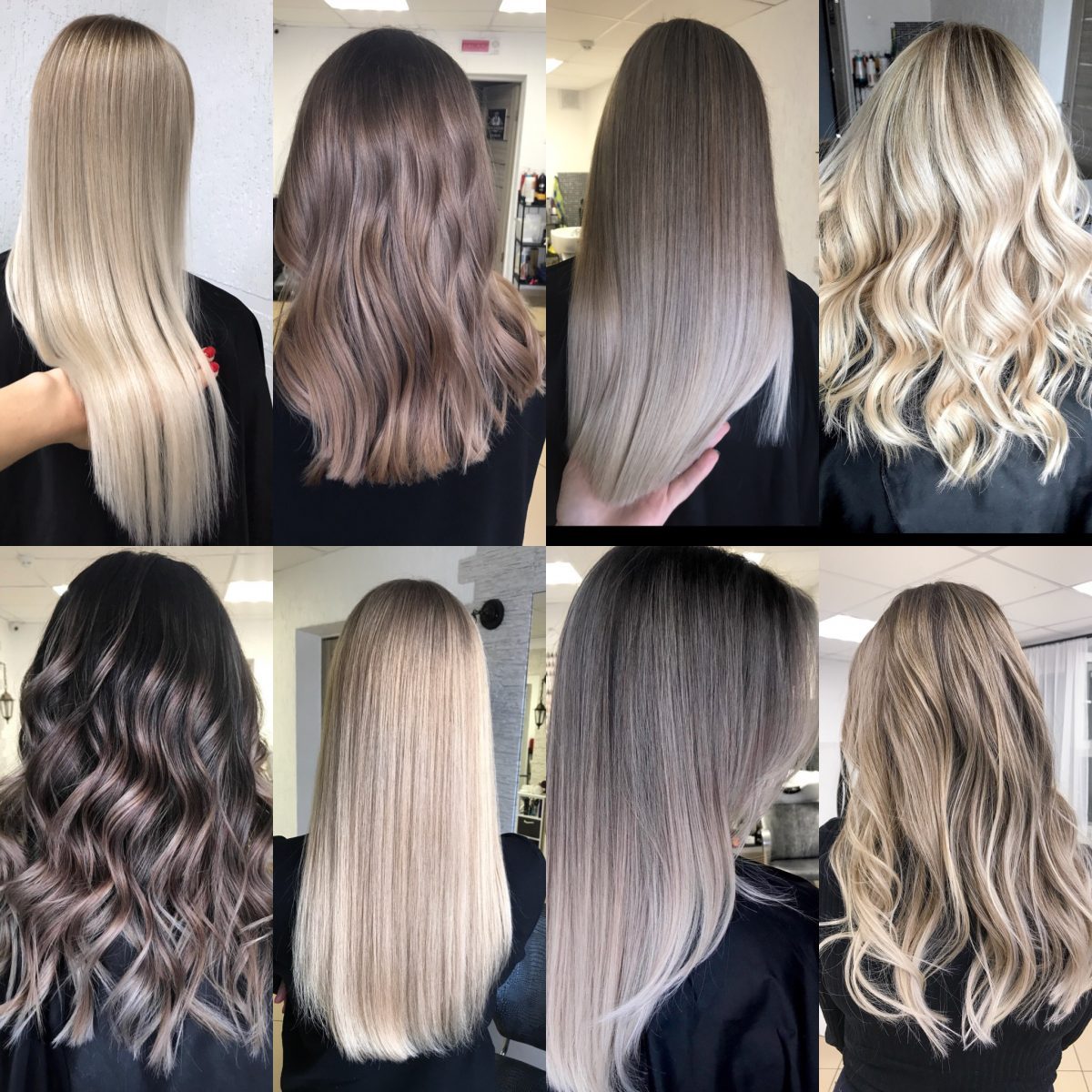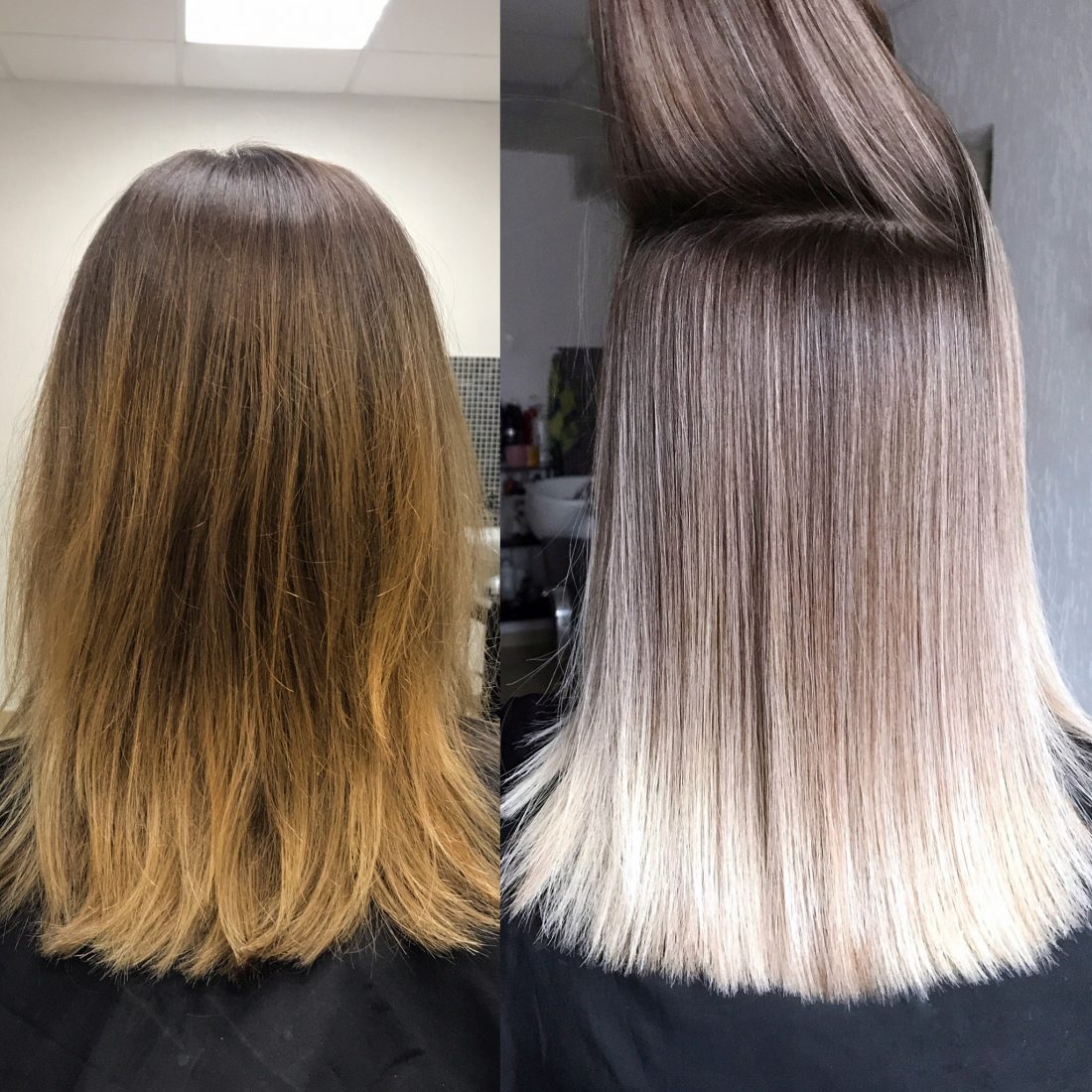What is Balayage?
Balayage was invented in the 1970s. The word itself originates from the French word "...".balayer"which means "to sweep".
The balayage is a dyeing technique of the hairwhere a lightener or colour is "swept" by hand through small triangular sections of hair, traditionally freehand or with the help of a trowel. This results in a beautiful, natural looking highlightslighter near the tips and softer at the top.
The technique first appeared in Paris and was called "...".Balayage à Coton"The colourists used (and some still use) cotton stripes to isolate the coloured strands from the untouched ones.
In the 1990s, the balayage became fashionable in the USA, but it is only now that this technique is reaching its peak of popularity. Nearly 80% of my works are balayage.
Benefits and Cons of Balayage Wicks
Benefits:
- Individuality: colours are custom blended, lighter strands are chosen in width and placement to properly contour and frame the features (balayage is sometimes referred to as a non-invasive 'facelift').
- Low maintenance: the roots are less noticeable as the hair grows, you will forget about monthly touch-ups, in most cases the touch-ups are every 6 months.
- Universality: works for all ages, hair textures, base colours and hair lengths.
- Less damage: when compared to full colour or techniques using heat.
Any disadvantages? Balayage highlights do not cover grey hair. When it is impossible, you will have to do a pre-balayage root dyeingand visit the salon every 4-6 weeks for a root touch-up to cover grey hair. Monthly appointments are a must.

How long does it take to do Balayage highlights?
The time of the balayage highlights depends on the style and depth of the highlights, your hair type. Face framing highlights can take 20 to 35 minutes, a full head balayage, about 2 hours depending on the more complicated type of colouring, up to 5 hours (e.g. if balayage highlights need to be transformed, or the roots need to be faded first).
On average, they book 3 to 5 hours.
To create a perfect shade match, stylists recommend having at least 3 colour appointments every 6 weeks. This is the only way to skip touch-ups for 3-6 months.
Why is balayage so popular?
It requires less maintenance than most hair dyes. Because the process is designed to give the appearance of roots in a flattering and natural rather than austere way, it is less laborious to maintain. That translates into less time and money spent at the salon and, in turn, less damage to the hair. Most of my clients have balayage retouches every 5 to 6 months, others opt for 8 weeks.
It is personalised. Every balayage is different: placement, gradation and colour are based on the colour, texture and length of your hair, and can be customised to highlight or soften the client's facial features. Always consider skin tone and natural base colour to determine which shades to recommend.
Keep in mind that no two balayages are identical. We do not follow a pattern, we observe and analyse the hair; cut, length and characteristics of the hair, in order to best suit each client.

All possible types of balayage highlights
The most common type of this technique is balayage complete , when the whole hair is highlighted.
The partial balayageis when the reflexes are applied only to specific areas rather than to the whole head.
The subtle balayage is a soft variation of balayage, the colour is applied to areas where it catches the light or where the colour would naturally fade. The opposite of high contrast balayage.
Foilayage is a further adaptation of balayage, create an effect similar to balayage but with a stronger contrast.
A modern reverse balayage (reverse balayage) for blondes and blondes, and darker colours (browns, greys) are used on the ends. The result is something in between balayage and ombré. Contrasting colours are used, so it requires a lot of maintenance.
The Babylights (micro-reflections) are very fine and subtle highlights. They have the longest lasting effect of all balayage types without months of touch-ups. One disadvantage: making babylights is a very refined job and can be time-consuming.
It is said that "the balayage was created by the Frenchspread by the Americans and customised by stylists all over the world. Actually, modern colourists invent something new in the world of highlights every day. Some of the names you may hear of the different highlighting techniques are balayage highlights:
- CALIFORNIAN BALAYAGEa heavier variant of the classic balayage with live roots, when a larger part of the hair is dyed.
- GLITTERAGE: a styling process when some strands are 'balayaged' with shine.
- STARDUST BALAYAGE: when the top layer is not touched and the bottom layer is highlighted.
- PALM-PAINTING: a technique for applying balayage highlights without a brush.
- SPONGLIGHT: when a lightener is spread with a sponge, it works very well for textured hair. projectors that are painted only in the middle of the strands.
- FALLAYAGE: She creation of different layers of colour, in honey, maple or light brown tones, adds a lot of shine to the hair. The hair colouring applied with this technique is carried out on light to brown hair. It is not used on dark hair.
The male balayage is also already a fashionable thing to do. They bring a number of advantages to any lookregardless of the type of wick chosen:
- They give visual depth to the hair, adding volume.
- They manage to disguise the lack of hair.
- Disguise grey hair if you prefer not to opt for a full colouring.
- Rejuvenate and illuminate the face.

Balayage vs Highlights
In general, the "reflections". are any strands of hair that are lighter than the base colour, no matter how they are made. Lowlights are darker strands.
Classic highlights usually have a distinct striped appearance and a more noticeable growth line. In most cases, films are used to create a more distinct... The traditional fuses are done from root to tip: they lift the roots.
Balayage is a highlighting TECHNIQUE. Results in well blurred vertical highlights that let us glimpse a gradient of darker shades at the roots and lighter shades at the ends or vice versa. The balayage highlights are strategically placed, some start higher and closer to the roots, some lower and some lighten the ends. In addition, it is a surface technique: a hair dye or lightener is applied only on the top layer of each section of hair, not saturated through the strands.
Balayage vs ombré
On the contrary, ombré is when a darker shade gradually washes to a lighter shade. Ombré is less personalised than balayageThe lighter shade is concentrated only at the tips. The transition is usually well defined and horizontal.
The next confusing term is the ombré balayage . This is a 'two-in-one' mix of the ombre-ed style and a balayage technique. Generally speaking, it is a dark to light shading with balayage highlights in the middle and at the ends.
Balayage vs. Other Techniques and Styles
Fluid hair painting is the process of applying a lightener/colour with the client's head lying on a table.
Flamboyage is not "outdoors", it is created with transparent adhesive strips. The technique results in soft balayage or peek-a-boo highlights.
Colour melt is a colouring scheme, when a stylist places 3-4 shades along the hair shaft and blurs them to eliminate the demarcation line.

Is Balayage suitable for all hair types?
Yes! "Any texture and colour can have a balayage". Even if your hair is super dark or curly, you can try these natural-looking highlights.
Can balayage be done at home?
You probably shouldn't. The balayage highlights may look natural and effortless, but unlike traditional single-process hair colour, the balayage techniques are very precise and require a lot of practice, it is difficult to do on your own. It also requires wrapping the strands of hair, so the colour can easily smudge on the other undyed hair.
How to choose a balayage specialist
Balayage is not as easy as it sounds. A colourist has to know how to choose the right products and apply them, perfectly understand the saturation process, what suits a client and what aftercare to recommend. It takes years to perfect balayage skills, so think twice before you do it: Think twice before you call anyone.
Balayage Wicks Price
This is something I am often asked How much do balayage highlights cost? Prices vary according to the stylist skills and many other factors such as the the length of the hair, the abundance of hair and the amount of product to usebut generally the price of a balayage highlights can vary from €50 to €350 and more. In general, be prepared to pay between 20 and 35 % more than for standard reflections, since the balayage is not something that all stylists are trained to do.
Some stylists charge an additional fee for additional product used, longer hair length, shade and glaze, a finishing style, for educational advice on hairstyles. There are no fixed prices, they are charged according to time and products used.
How to maintain your balayage highlights
While the balayage highlights allows you to go almost a year without colouring your hair, that doesn't mean you're completely hassle-free when it comes to maintenance. To keep colour fresh between visits, a rich, moisturising hair mask is needed. It has also been shown that a violet or blue shampoo balances coppery tones that may arise between the dyes.



Add a Comment